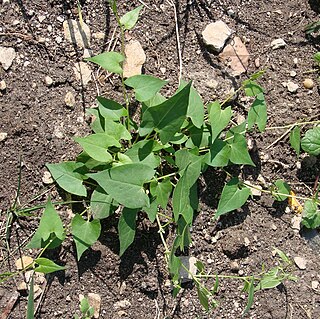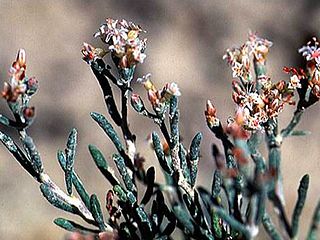
Fallopia convolvulus, the black-bindweed or wild buckwheat, is a fast-growing annual flowering plant in the family Polygonaceae native throughout Europe, Asia and northern Africa.

Eriogonum fasciculatum is a species of wild buckwheat known by the common names California buckwheat and flat-topped buckwheat. Characterized by small, white and pink flower clusters that give off a cottony effect, this species grows variably from a patchy mat to a wide shrub, with the flowers turning a rusty color after blooming. This plant is of great benefit across its various habitats, providing an important food resource for a diversity of insect and mammal species. It also provides numerous ecosystem services for humans, including erosion control, post-fire mitigation, increases in crop yields when planted in hedgerows, and high habitat restoration value.

Eriogonum parvifolium is a species in the family Polygonaceae that occurs on dune formations in the coastal area of Central and Southern California. This evergreen shrub grows to a height of 30 to 100 centimeters with a spread of approximately the same dimension. This plant is an important host for a number of pollinating insects including certain endangered species. E. parvifolium occurs both on bluffs along the Pacific Ocean coast as well as Coastal Strand dunes formations, but is restricted to altitudes below 700 meters. In at least one instance within the Carbonera Creek watershed, it occurs farther inland in a Maritime Coast Range Ponderosa Pine forest. This shrub is also known by the common names dune buckwheat, coast buckwheat, cliff buckwheat, or seacliff buckwheat.

Eriogonum alpinum is a species of wild buckwheat known by the common name Trinity buckwheat.
Eriogonum dasyanthemum is a species of wild buckwheat known by the common name chaparral buckwheat. This plant is endemic to California where it is limited to the Northern Coast Ranges, but it is quite common in its native range.

Eriogonum flavum is a species of wild buckwheat.
Chorizanthe breweri is a rare species of flowering plant in the buckwheat family known by the common names San Luis Obispo spineflower and Brewer's spineflower. It is endemic to California, where it is known from about twenty occurrences in the Central Coast Ranges of San Luis Obispo and far southern Monterey Counties. It grows in the chaparral and woodlands of the range, generally on serpentine soils. This small plant produces decumbent stems extending along the ground and sometimes growing upright to a maximum length of about half a meter. The herbage is mostly reddish in color and somewhat hairy. The inflorescence is a cluster of flowers, each surrounded by six hairy reddish bracts with hooked tips. The flower itself is only about 3 millimeters wide and is white to red and hairy.

Chorizanthe douglasii is a species of flowering plant in the buckwheat family known by the common names San Benito spineflower and Douglas' spineflower. It is endemic to California, where it grows in the mountains of the Southern California Coast Ranges, from the Santa Lucia Range east to the Gabilan Range.
Chorizanthe leptotheca is a species of flowering plant in the buckwheat family known by the common names Ramona spineflower and Peninsular spineflower. It is native to the Peninsular Ranges of southern California and Baja California, where it grows in chaparral and forest habitat. It is very similar to its close relative, Turkish rugging.
Chorizanthe obovata is a species of flowering plant in the buckwheat family known by the common name spoonsepal spineflower. It is endemic to California, where it grows in the mountains of the Central Coast Range from Monterey to Santa Barbara Counties.
Chorizanthe rectispina is a species of flowering plant in the buckwheat family known by the common names prickly spineflower and straight-awned spineflower. It is endemic to California, where it is known from about twenty occurrences from Monterey to Santa Barbara Counties. It grows in dry habitat types such as chaparral and woodland in the hills of the Central Coast Ranges. It is a low, spreading plant with stems up to about 25 centimeters long, grayish to greenish in color and hairy in texture. The inflorescence is a cluster of flowers, each flower surrounded by six hairy bracts which are grayish to pink in color and tipped with awns. One bract is longer than the others and has a straight awn, and the other smaller bracts may have hooked awns. The tiny flower at the center of the bract array is a few millimeters wide and white and yellow in color.

Chorizanthe xanti is a species of flowering plant in the buckwheat family known by the common name Riverside spineflower. It is endemic to California, where it grows in several of the mountain ranges from the Sierra Nevada to the Southern California Transverse Ranges in forest, woodland, and scrub habitats.

Eriogonum brachyanthum is a species of wild buckwheat that is commonly known as shortflower buckwheat. It is native to eastern California and western Nevada, particularly the Mojave Desert region, where it is common to abundant, and even sometimes weedy. It is also known from southern Oregon. The plant grows in sandy habitats such as desert flats and sagebrush. It also grows in pinyon-juniper and montane conifer woodlands. It is an annual herb that grows 30 to 40 centimeters tall. Leaves are located at the base of the stem, woolly, and oval or rounded in shape. The top of the stem is occupied by a branching inflorescence bearing many widely spaced clusters of flowers. Each individual flower is about a millimeter wide and light yellow in color. Flowers bloom from April to November.

Eriogonum butterworthianum is a rare species of wild buckwheat known by the common name Butterworth's buckwheat. It is endemic to the Santa Lucia Mountains of central Monterey County, California, where it is known from a few occurrences in the wilderness southeast of Big Sur in the vicinity of Junipero Serra Peak. Its native habitats include oak and conifer woodlands, chaparral communities, and sandstone outcrops. Eriogonum butterworthianum is a small clumpy shrub or subshrub that grows up to about 30 centimeters tall and wide. Leaves are 2 centimeters long and reddish-green in color. They are woolly, oval in shape, and curled under at the edges. The inflorescence is a cluster of flowers up to 2 or 3 centimeters wide. Each individual flower is a few millimeters wide and dull yellowish to pinkish in color. Flowers bloom June to September.

Eriogonum cernuum is a species of wild buckwheat known by the common name nodding buckwheat. It is native to much of western North America, where it grows in sandy and gravelly habitat, including woodland and sagebrush. It is an annual herb growing up to about 60 centimeters in maximum height with a thin, branching flowering stem. The rounded, woolly leaves are one or two centimeters wide and are mainly located about the base of the stem. The inflorescence is evenly lined with hanging involucres of flowers. The individual flowers are less than 2 millimeters wide and white to pink-tinged in color.

Eriogonum cithariforme is a species of wild buckwheat known by the common name cithara buckwheat.

Eriogonum sphaerocephalum is a species of wild buckwheat known by the common names rock buckwheat and round-headed desert buckwheat. It is native to the western United States.

Eriogonum ternatum is a species of wild buckwheat known by the common name ternate buckwheat. It is native to mountain ranges of northern California and southern Oregon, where it grows in the serpentine soil of the forests. This is a perennial herb forming mats up to half a meter wide with rosetted clusters of oval to rounded woolly leaves each about a centimeter long. The inflorescence arises on a flowering stem and bears an umbel of bright yellow flowers.

Eriogonum pelinophilum is a rare species of wild buckwheat known by the common name clay-loving wild buckwheat. It is endemic to the state of Colorado in the United States, where it is known from only two counties. The most recent estimates available suggest there are 12 occurrences in existence for a total of about 278,000 individual plants in Delta and Montrose Counties. At least 7 occurrences observed in the past have not been relocated but are not yet believed extirpated. This plant is federally listed as an endangered species of the United States.

Eriogonum soredium is a species of wild buckwheat known by the common name Frisco buckwheat. It is endemic to Utah in the United States, where it is known only from Beaver County. There are four populations, all located in the San Francisco Mountains. It is a candidate for federal protection.















